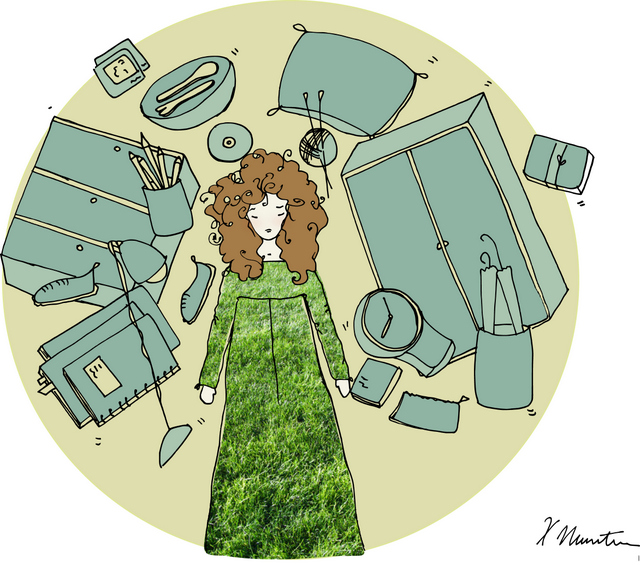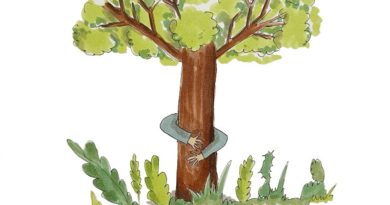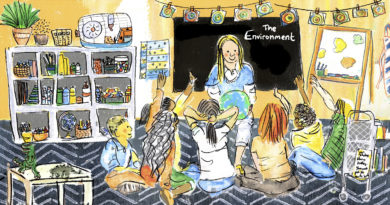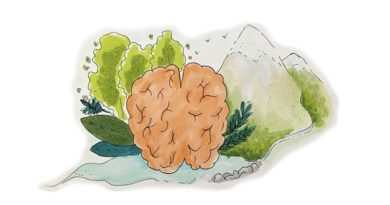Objects: An Inquiry
Do not trouble yourself much to get new things….Things do not change; we change. Sell your clothes and keep your thoughts…. (Henry David Thoreau, Walden)
Originally published in Mothering Matters in October 2008
Manmade objects can make me quite anxious. For example, I have been cleaning up some of our bookshelves. We have lots of books, which I would like to sort through but do not have time, so I am mainly trying to get like things with like (all German books together, for example) and determine what papers can be discarded. However, this process can be like quicksand: I can really get stuck. I opened a folder from last summer, when we were in San Diego, and memories and feelings from that time flooded over me. I had to make a concerted effort to stay on task and not wallow around in the past for hours. The anxiety comes in when I look around me and think, Where did all this stuff come from, and should I really keep it?
My children also tend to wallow around in the past, lured by artifacts. For example, I put an old, completed coloring book on the recycling pile—just a cheap Finding Nemo thing where outline pictures appear “out of nowhere” when you color over them with a special marker – an utterly frivolous gift to my son from his grandmother. My son picked it up and settled in to look at it. He would surely have spent 15-20 minutes engrossed in this thing, observing the images and harking back to when they first “magically” appeared. Maybe this wouldn’t be a problem if we did not have mountains of reading material for him to become engrossed in – all of it far better (I re-directed him to a booklet of pictures he had drawn himself, and he was happy with that).
However, the ability and desire to spend hours in the past, pulled back by these artifacts, confounds and frustrates me. After years of experiencing this, I feel it too often keeps me from moving forward.
Even beyond the hypnotic pull of disorganized clutter, though, I have started to wonder: what does it mean that we have so many things in our lives? I mean the manmade things: papers, books, artifacts, tools, and knickknacks, just to name a few. Part of it, of course, is that our lives are so complicated. (Our need for stuff is both a cause and an outgrowth of that.) We need to be so many places over the course of a day, so we have cars, bicycles, strollers, buses, trams, etc. We wear clothes not only for protection and warmth, but also for self-expression. Our homes – often large things in themselves – are filled with furniture and decorations. We don’t need these things to survive, necessarily, but they are often useful, comfortable and fun, of course.
Step back for a moment, to infancy. When a baby begins to focus on his surroundings, what does he see? Objects: the furniture, pictures, the patterns on his mother’s shirt, even buildings. Yes, he also sees the faces of his family and bits of nature outside. But he probably has more opportunity to gaze upon sheets, mobiles, and toys, etc. He becomes familiar with the everyday routine of his mostly manmade world. Furthermore, I think a baby “imprints” on these things….they take up permanent residence in his psyche. His eyes, newly seeing, send his fresh brain images that will dwell there forever: images of manmade items that are not organic, as he is. He imprints on a world of things that will not grow old and die, as he and his family someday will.
What does it mean that we stuff our brains with images of artifice from the earliest age? Furthermore, do manmade objects create anxiety over mortality?
What if a newborn baby only saw natural things? What if, instead of a mobile, she gazes at a tree and the changing shadows on its leaves and branches? If there are no toys or furnishings to distract the eye, a baby will have to watch clouds or leaves, sunlight and shadows, or, of course, the faces and bodies of the people around her. She will “imprint” on other, mainly organic, objects.
In imprinting on these natural objects, a baby takes part in the world around him. She stores images of things that, like her, have a life force—and will eventually grow old and die.
Manmade objects may have a curious effect on our wellbeing. Our artificial objects do not go away. If we ignore them for 25 years, they will get dusty and, possibly, brittle. Even if we give them away or sell them, they may be used for 30 more years. And they could still look much as they did they day they came out of their packaging or off the presses. They do not participate in the organic life cycle in the same way we do, and this can be bothersome to the soul.
Think of what happens when children bring home seasonal items, like leaves and berries and nuts. They play with these, and as the months of autumn pass, the items change: they wither or decompose. They let us know when to let go of them in a way that manmade items cannot.
Many of you have probably heard that researchers have discovered that everyone benefits from exposure to the natural world. Office workers are more productive when their offices have windows looking out into green. Nature improves kids’ mental functions, and children with ADHD experience reduced symptoms after spending time in outdoor green spaces. It is not only any old place outdoors, it is the green of grass and trees that gives the psychological benefit. Richard Louv, author of Last Child in the Woods (2005), has coined the term nature-deficit disorder, in part to describe how reduced or non-existent time outdoors, combined with the lure of electronic media, has given rise to a number of behavioral disorders.
It is difficult to prioritize time in nature when there is so much stuff to be organized, managed and used, of course.
The other day I read an article that described the birth of civilization. It said, “One of the main innovations of the settled life based on farming was the capacity to accumulate more than was needed to live.” Many thousands of years later, our culture takes this capacity for granted, and we accumulate not only food but also (manmade) things. It is worth stepping back and considering what this means for the human spirit. We put too much of ourselves into these unchanging things. I certainly have trouble deciding how much meaning to give them, and when to let them go.
I am certain that we would be better off “imprinting” almost exclusively on the organic, from infancy, and training our eyesight on objects that, like us, naturally grow old and die. The distraction of the manmade, with its seeming constancy, takes our attention away from our true “natures” and confuses us with false images of immortality.
By Carol McDonald.
Burak, Tammy. “Are Your Kids Really Spending Enough Time Outdoors?” at CanadianLiving.com: www.canadianliving.com/family/parenting/are_your_kids_really_spending_enough_time_outdoors_2.php
“It’s the Nature of the Job,” Psychology Today online: psychologytoday.com/articles/pto-19931101-000023.html
Illustration by Laura Munteanu
Laura has studied Journalism and Advertising, and has worked as a journalist and an illustrator. She has illustrated for magazines, websites, charity and various campaigns. Laura lives in Zurich with her husband and five -year- old daughter.




